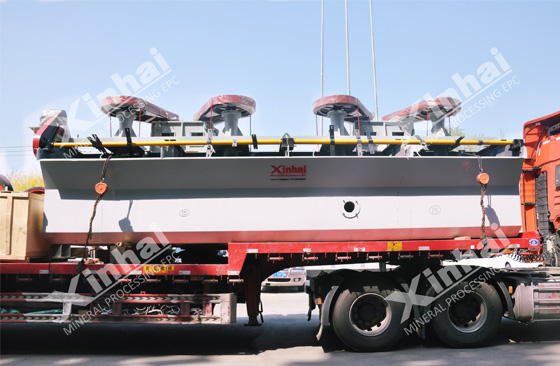

Warm Tip: If you want to know more details about equipment, solutions, etc, please click the button below for free consultation, or leave your requirements!
Froth flotation is the most widely used phosphate ore separation process. Because of the nature of the phosphate ore, such as mineral types and content, disseminated particle size, its separation difficulty and flotation types varies. Phosphate ore is divided into siliceous phosphorite, calcareous phosphorite, and siliceous phosphorite according to the chemical composition of the minerals.The froth flotation types differ from different types of phosphate ore greatly. The following is a brief introduction to 5 common types of phosphate ore forth flotation process.

The direct froth flotation process is to grind the phosphate ore until the minerals among the ore are dissociated after one stage grinding, suppress the gangue minerals by adding inhibitors, and then add the collector to enrich the phosphate minerals in the foam. This process must be combined with strong inhibitors to obtain best effect. It is mainly suitable for phosphate ore with phosphate and gangue minerals in fine partical size, as well as separation of low-grade phosphate ore, including siliceous and siliceous calcium phosphate ore.
Low impurity content and obvious impurity removal effect.
Relatively low processing cost.
Simple process and easy operation. For medium and low grade phosphate ore, especially for ore with MgO mass fraction less than 2%, the concentrate MgO mass fraction will be less than 1% by direct froth flotation process. Therefore, there is no need for two-stage froth flotation, thus simplifying the process.
The reverse flotation process is to adjust PH of the slurry to 5.0 ~ 6.0, inhibitphosphate mineral by adding inhibitors, and then enrich carbonate in the foam with a selective collector. The process is mainly suitable for calcium-magnesia colloidal phosphate ore with high calcium and magnesium content, and it is effective to separate sedimentary calcium-magnesite phosphate ore.
Simple process, high carbonate separation.
Fast flotation speed, high flotation efficiency.
Ambient-temperature flotation completed., The coarser particle size of the product in the tank is conducive to product post-processing.
The direct-reverse froth flotation is to use inorganic alkali to adjust the slurry to weak alkalinity, enrich the useful phosphorus minerals in the foam product by using a specific collector, and leave the silicate gangue minerals in the tank to discharge, the foam is direct flotation concentrate. Then add mineral acid to adjust the slurry to weak acidity, after mixing the slurry of the flotation concentrate (re-grinding or not grinding), enrich the carbonate impurities with a collector, and leave the useful phosphate minerals in the tank to obtain reverse flotation concentrate. The reverse flotation operation is mainly to remove MgO impurities in the phosphate concentrate. Its mainly suitable for calcium-magnesium mixed colloid phosphate ore with high silicate.
Strong adaptability to raw ore quality. The range of raw ore grades that can be processed for phosphate ore: P2O5: 14% ~ 25%, SiO2: 12% ~ 35%, MgO: 1% ~ 8%.
Phosphate concentrate is a product in the tank with a coarser particle size, which is easier to dehydrate than foam products, and easy to settle and transport.
This process order is opposite to the direct-reverse froth flotation, which is mainly suitable for mixed colloidal phosphate ore with high carbonate. The mineral particle size -200 mesh mass fraction will account for 70% ~ 80%, most ofthe carbonate has been dissociated by the monomer after grinding. At this time, the carbonate gangue will surface using the collector under acidic medium conditions to obtain the reverse flotation concentrate, then carry out two stages grinding until the siliceous gangue dissociates, and phosphorus minerals will surface under the condition of alkaline medium to obtain direct flotation concentrate. The second stage grinding produces a fresh surface, which is more conducive to the separation of phosphorus and silicon.
The process is similar to the direct-reverse froth flotation, which also has strong adaptability to raw ore quality.
High degree of enrichment, ideal concentrate index, improve recovery rate effectively.
Low acid consumption, the use of phosphoric acid as an inhibitor is beneficial to reduce reagent cost.
Double reverse flotation is mainly used for the separation of phosphorus minerals from dolomite and quartz gangue minerals. Generally, theslurry is adjusted to weak acidity with inorganic acid, then fatty acid collector is used to enrich dolomite gangue minerals in the foam, and fatty amine collector is used to enrich quartz gangue minerals, leaving useful phosphorus minerals in the tank.
It can realize low or normal temperature flotation, and sometimes it can be carried out at a coarser particle size, simplifying the beneficiation process and saving energy consumption.
The coarser particle size of the product in the tank is conducive to product post-processing.
The wastewater is acidic, which is beneficial to the recycling of the whole plant.
The above 5 types of forth flotation process have different process advantages and are suitable for different types of phosphate rock. Only by selecting appropriate flotations types for different phosphate ores can we obtain high recovery rate of phosphate concentrate. It is recommended to entrust a qualified beneficiation laboratory or beneficiation service provider to conduct a flotation test, formulate a scientific and reasonable process flow, and determine the type of froth flotation process according to the nature of the ore, so as to avoid economic losses.
